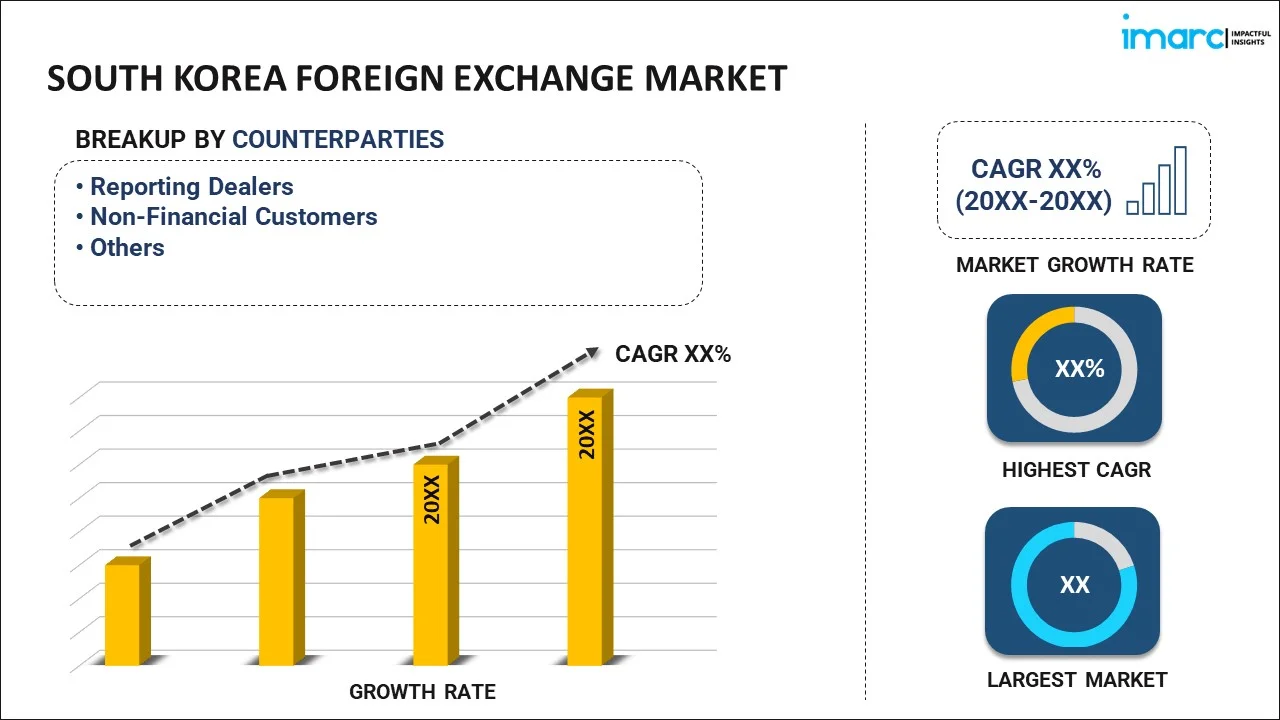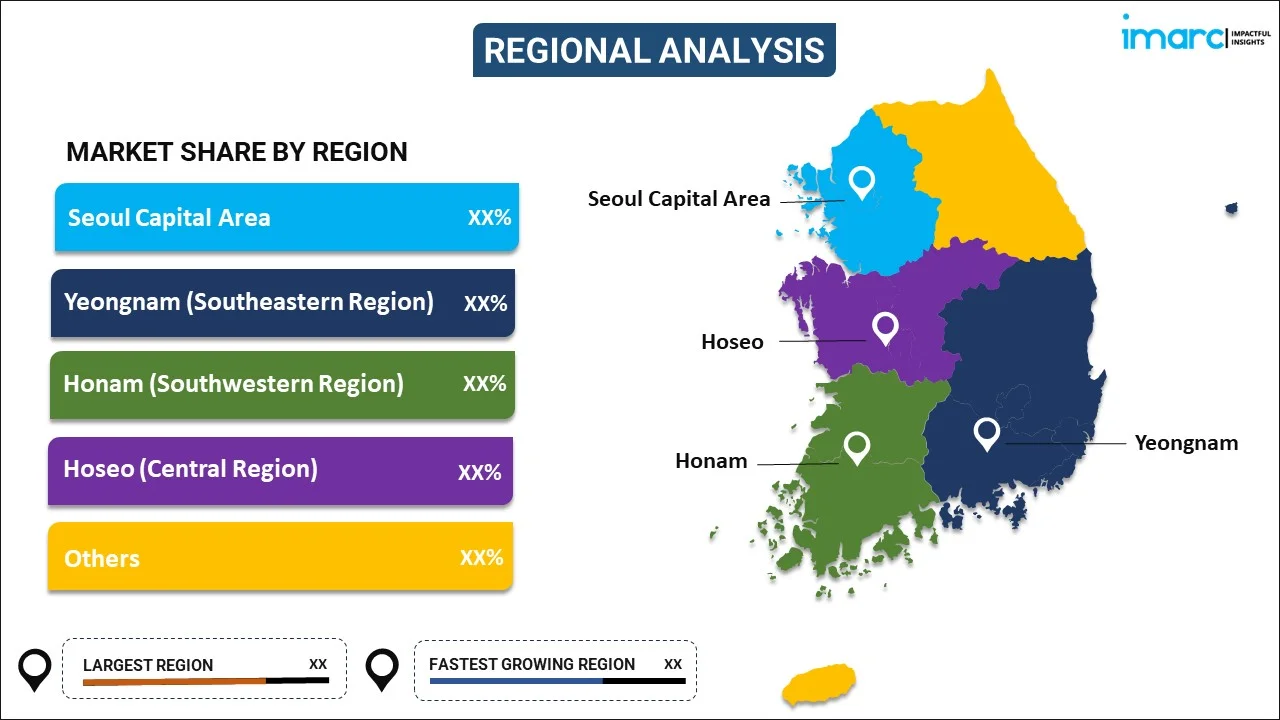
South Korea Foreign Exchange Market Report by Counterparty (Reporting Dealers, Non-Financial Customers, and Others), Type (Currency Swap, Outright Forward and FX Swaps, FX Options), and Region 2025-2033
Market Overview:
South Korea foreign exchange market size is projected to exhibit a growth rate (CAGR) of 10.50% during 2025-2033. The increasing prevalence of traders in the forex market, which often engage in speculative activities, buying and selling currencies based on anticipated future movements, is driving the market.
|
Report Attribute
|
Key Statistics
|
|---|---|
|
Base Year
|
2024 |
|
Forecast Years
|
2025-2033
|
|
Historical Years
|
2019-2024
|
| Market Growth Rate (2025-2033) | 10.50% |
Foreign exchange, often abbreviated as forex or FX, refers to the marketplace where currencies are traded. It serves as a decentralized financial market, allowing participants, including banks, financial institutions, corporations, and individual traders, to buy and sell currencies. The primary purpose of foreign exchange is to facilitate international trade and investment by enabling the conversion of one currency into another. Participants engage in forex trading to take advantage of exchange rate fluctuations, aiming to profit from the relative strength or weakness of different currencies. Major currency pairs and prices are influenced by various factors like economic indicators, geopolitical events, and market sentiment. Central banks and governments play a crucial role in shaping currency values through monetary policies and interventions. The foreign exchange market operates 24 hours a day, five days a week, due to the nature of currency trading.
South Korea Foreign Exchange Market Trends:
The foreign exchange market in South Korea is a dynamic financial arena influenced by a multitude of factors that collectively determine currency values. Primarily, economic indicators play a pivotal role in shaping market dynamics. For instance, interest rates, a cornerstone driver, impact currency values as central banks adjust them to control inflation and spur economic growth. Furthermore, economic data such as GDP growth, employment figures, and manufacturing indices contribute to market volatility. Political events also exert significant influence on the forex market. Elections, geopolitical tensions, and policy decisions can swiftly alter investor sentiment and subsequently impact currency valuations. Moreover, regional trade dynamics, including trade balances and tariffs, are integral components that guide market movements. In an increasingly interconnected world, news and information dissemination occur rapidly, making market sentiment susceptible to sudden shifts. Technological advancements and market innovations further drive the forex market. Electronic trading platforms, algorithmic trading, and high-frequency trading have revolutionized the speed and efficiency of currency transactions. Market participants closely monitor these developments to gain a competitive edge. In essence, the regional forex market is a complex ecosystem where economic, political, and technological drivers converge, creating a dynamic landscape that traders navigate to make informed decisions.
South Korea Foreign Exchange Market Segmentation:
IMARC Group provides an analysis of the key trends in each segment of the market, along with forecasts at the country level for 2025-2033. Our report has categorized the market based on counterparty and type.
Counterparty Insights:

- Reporting Dealers
- Non-Financial Customers
- Others
The report has provided a detailed breakup and analysis of the market based on the counterparty. This includes reporting dealers, non-financial customers, and others.
Type Insights:
- Currency Swap
- Outright Forward and FX Swaps
- FX Options
A detailed breakup and analysis of the market based on the type have also been provided in the report. This includes currency swap, outright forward and FX swaps, and FX options.
Regional Insights:

- Seoul Capital Area
- Yeongnam (Southeastern Region)
- Honam (Southwestern Region)
- Hoseo (Central Region)
- Others
The report has also provided a comprehensive analysis of all the major regional markets, which include Seoul Capital Area, Yeongnam (Southeastern Region), Honam (Southwestern Region), Hoseo (Central Region), and Others.
Competitive Landscape:
The market research report has also provided a comprehensive analysis of the competitive landscape in the market. Competitive analysis such as market structure, key player positioning, top winning strategies, competitive dashboard, and company evaluation quadrant has been covered in the report. Also, detailed profiles of all major companies have been provided.
South Korea Foreign Exchange Market Report Coverage:
| Report Features | Details |
|---|---|
| Base Year of the Analysis | 2024 |
| Historical Period | 2019-2024 |
| Forecast Period | 2025-2033 |
| Units | US$ Billion |
| Scope of the Report | Exploration of Historical and Forecast Trends, Industry Catalysts and Challenges, Segment-Wise Historical and Predictive Market Assessment:
|
| Counterparties Covered | Reporting Dealers, Non-Financial Customers, Others |
| Types Covered | Currency Swap, Outright Forward and FX Swaps, FX Options |
| Regions Covered | Seoul Capital Area, Yeongnam (Southeastern Region), Honam (Southwestern Region), Hoseo (Central Region), Others |
| Customization Scope | 10% Free Customization |
| Report Price and Purchase Option | Single User License: US$ 3699 Five User License: US$ 4699 Corporate License: US$ 5699 |
| Post-Sale Analyst Support | 10-12 Weeks |
| Delivery Format | PDF and Excel through Email (We can also provide the editable version of the report in PPT/Word format on special request) |
Key Questions Answered in This Report:
- How has the South Korea foreign exchange market performed so far and how will it perform in the coming years?
- What has been the impact of COVID-19 on the South Korea foreign exchange market?
- What is the breakup of the South Korea foreign exchange market on the basis of counterparty?
- What is the breakup of the South Korea foreign exchange market on the basis of type?
- What are the various stages in the value chain of the South Korea foreign exchange market?
- What are the key driving factors and challenges in the South Korea foreign exchange?
- What is the structure of the South Korea foreign exchange market and who are the key players?
- What is the degree of competition in the South Korea foreign exchange market?
Key Benefits for Stakeholders:
- IMARC’s industry report offers a comprehensive quantitative analysis of various market segments, historical and current market trends, market forecasts, and dynamics of the South Korea foreign exchange market from 2019-2033.
- The research report provides the latest information on the market drivers, challenges, and opportunities in the South Korea foreign exchange market.
- Porter's five forces analysis assist stakeholders in assessing the impact of new entrants, competitive rivalry, supplier power, buyer power, and the threat of substitution. It helps stakeholders to analyze the level of competition within the South Korea foreign exchange industry and its attractiveness.
- Competitive landscape allows stakeholders to understand their competitive environment and provides an insight into the current positions of key players in the market.
Need more help?
- Speak to our experienced analysts for insights on the current market scenarios.
- Include additional segments and countries to customize the report as per your requirement.
- Gain an unparalleled competitive advantage in your domain by understanding how to utilize the report and positively impacting your operations and revenue.
- For further assistance, please connect with our analysts.
 Inquire Before Buying
Inquire Before Buying
 Speak to an Analyst
Speak to an Analyst
 Request Brochure
Request Brochure
 Request Customization
Request Customization




.webp)




.webp)












